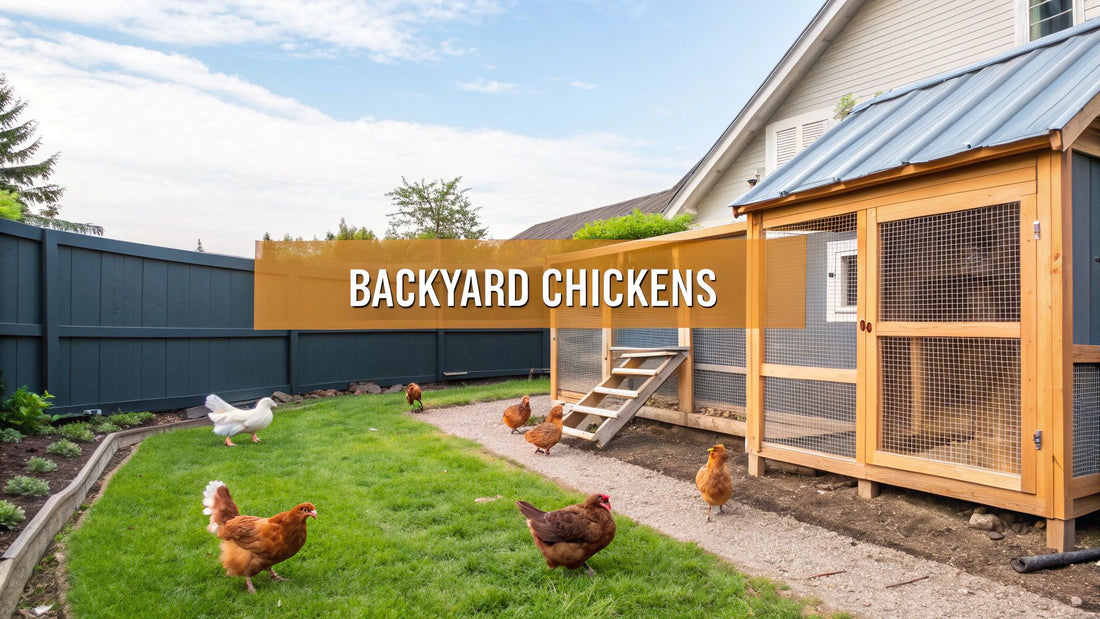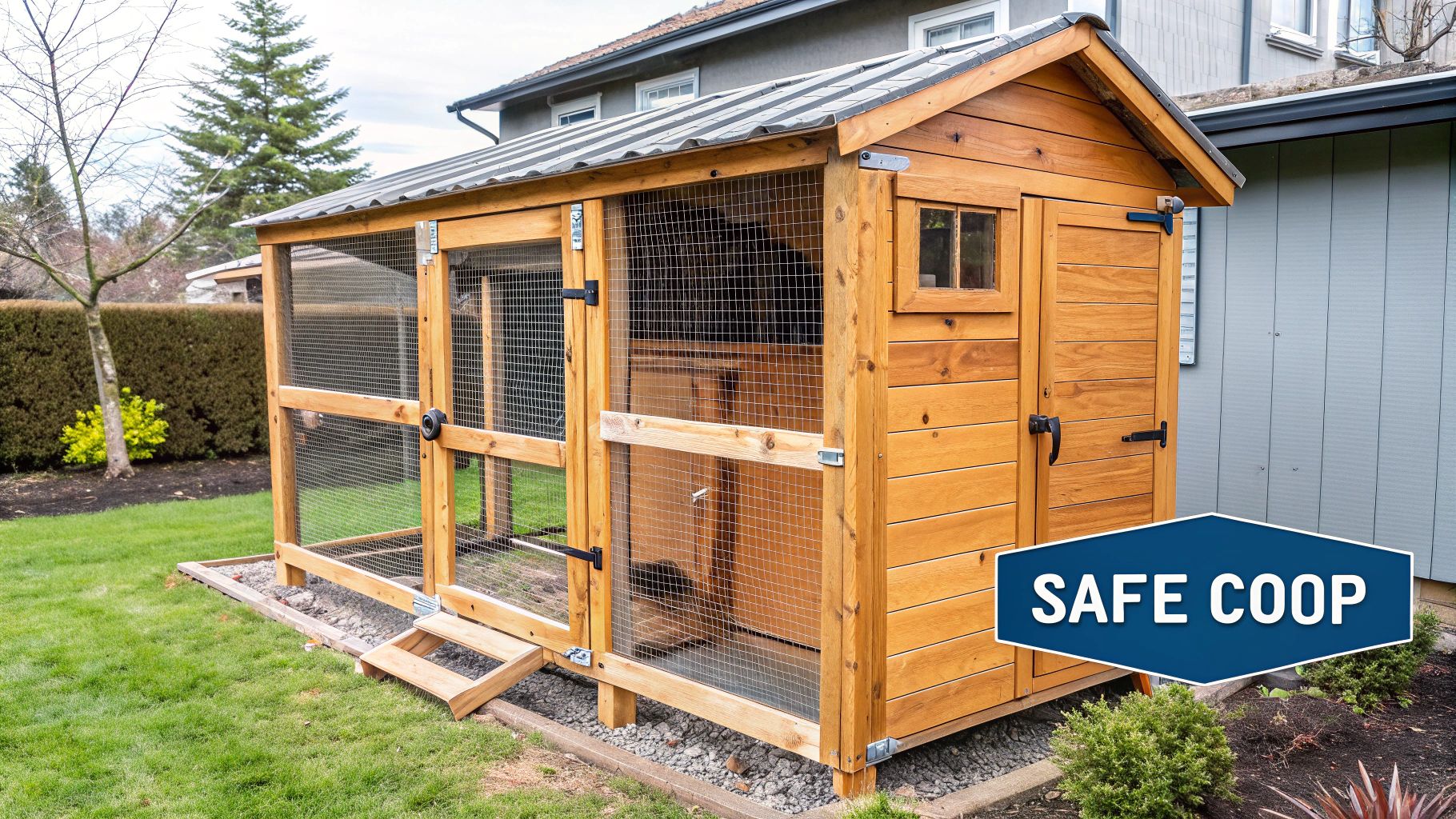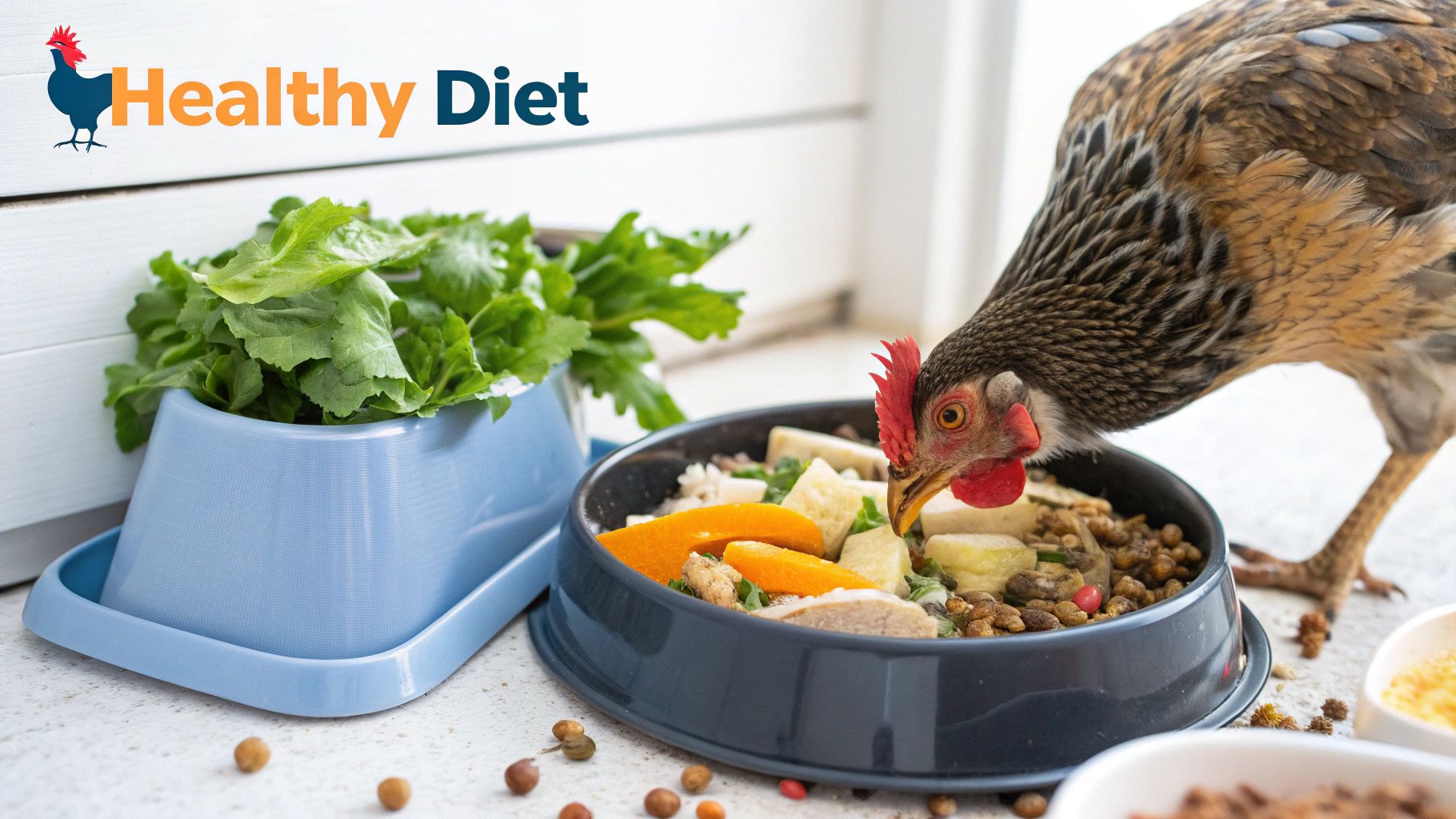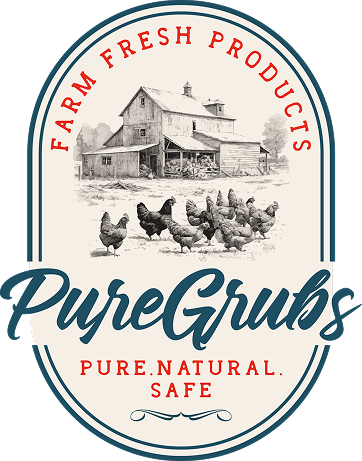
How to Raise Backyard Chickens The Ultimate Guide
Share
So, you're thinking about getting backyard chickens. Fantastic! It's an incredibly rewarding journey that starts with a few key steps: checking local rules, picking the right birds, setting up a solid coop, and getting their food and daily care dialed in. Before you know it, you'll be collecting fresh eggs right from your own yard.
Your Journey into Backyard Chicken Keeping
Welcome to the wonderfully quirky world of backyard chickens! Let's be honest, it's more than just a hobby—it's a lifestyle. Keeping a small flock connects you to where your food comes from in a really tangible way, not to mention they're endlessly entertaining. This guide is here to walk you through everything, making sure you feel ready for the adventure.
Most people get started because they dream of fresh, delicious eggs, and I don't blame them. The difference is night and day. But you'll quickly discover the benefits go way beyond the breakfast table. Chickens are sustainability superstars, turning your kitchen scraps into amazing fertilizer for the garden and cutting down on food waste.
What often surprises new chicken keepers is just how much personality these birds have. They're curious, funny, and can be surprisingly affectionate. It’s not long before they feel like part of the family, and the experience teaches everyone, especially kids, a lot about responsibility and the rhythms of nature.
The infographic below breaks down the most common reasons people jump into raising chickens.
As you can see, fresh eggs are almost always the main driver, but sustainability and pure family enjoyment are right up there, too.
Why Backyard Chickens Are Gaining Popularity
This isn't just a fleeting trend. The growing interest in backyard chickens is part of a bigger shift toward more sustainable, hands-on living. People everywhere are getting more interested in food security and knowing exactly what’s on their plate.
The numbers back this up. The global chicken coop market alone is valued at USD 562.3 million in 2025 and is projected to hit USD 907.2 million by 2035. That's a huge jump, and it shows just how many people are getting on board. You can dig into more data on the rise of backyard chicken keeping from The Chicken Fountain if you're curious.
From navigating local ordinances to building a Fort Knox-style coop and finally holding that first warm, perfect egg, we'll cover it all. Think of this as your complete roadmap to raising a happy, healthy, and productive flock.
Navigating Local Laws and Choosing Your Flock

Before you fall in love with those adorable, fluffy chicks online, there’s some crucial homework to do. The single most important first step—the one that will save you from major headaches later—is figuring out your local laws. Jumping the gun on this is a classic rookie mistake.
This isn’t just a friendly suggestion; it’s the foundation of your whole chicken-keeping adventure. You’re joining a huge movement—as of 2025, an estimated 13 million U.S. households are raising their own flocks. This surge in popularity, driven by egg prices and a desire for self-sufficiency, means about 93% of dense U.S. cities now allow backyard hens. But every single one has its own rulebook. You can get more background on this trend from the World Animal Foundation.
Cracking the Code on Local Ordinances
So, where do you find these rules? The easiest place to start is a quick search for "[Your City Name] poultry ordinance" or "[Your County Name] chicken regulations." These rules are usually buried deep within the municipal code, often under headings like "animal control" or "public health."
If Google doesn't give you a clear answer, pick up the phone and call your local city hall or county clerk. They'll know exactly who to talk to. You're looking for specifics on a few key things:
- Flock Size Limits: Most towns will cap how many birds you can have, usually somewhere between three and six hens for a typical residential lot.
- Rooster Restrictions: This one is a biggie. Roosters are almost universally banned in urban and suburban areas because of their crowing. When buying chicks, make sure you order "sexed" females to avoid an accidental (and very loud) surprise.
- Coop Setbacks: Your ordinance will tell you exactly how far your coop needs to be from property lines and your neighbors' houses. A 15-25 foot setback is pretty standard.
- Permits and Licensing: Some communities require you to get a permit or register your flock. It’s usually a simple form and a small fee.
Don't get discouraged if the rules seem complicated. Many cities have updated their laws because people just like you asked for it. Getting this sorted out now means you can start your journey on the right foot.
Choosing the Right Chicken Breeds for You
Once you've got the legal stuff handled, you get to the fun part: picking your chickens! The sheer number of breeds can feel overwhelming at first, but it gets a lot easier when you focus on what matters most to you—your climate, how many eggs you want, and the kind of personality you're looking for in your flock.
Temperament and Family Friendliness
If you have kids or just want your chickens to be friendly backyard pets, their temperament is everything. You'll want a breed known for being calm and easy to handle.
- Buff Orpingtons: These are the golden retrievers of the chicken world. They’re big, fluffy, and incredibly sweet-natured.
- Barred Rocks: A classic American breed that’s as friendly as it is reliable. They're curious birds and great, steady layers.
- Wyandottes: These are beautiful, calm birds that come in all sorts of cool color patterns. They’re another fantastic choice for a family flock.
Egg Production and Color
Let’s be honest, the fresh eggs are a huge part of the appeal! Different breeds lay at different rates and, best of all, come in a rainbow of eggshell colors. For a deeper dive into getting the most out of your layers, our guide on breeding chickens for eggs is a great resource.
- Leghorns: If your goal is a mountain of white eggs, this is your bird. They are production machines, often laying 280+ eggs a year.
- Ameraucanas/Easter Eggers: These are the birds that lay those gorgeous blue and green eggs. They add an immediate "wow" factor to your egg carton.
- Marans: Famous for their rich, chocolate-brown eggs, Marans are a backyard favorite for anyone wanting something truly special.
Here's a quick comparison to help you narrow down your choices.
Popular Backyard Chicken Breeds at a Glance
| Breed Name | Temperament | Egg Production | Best Climate |
|---|---|---|---|
| Buff Orpington | Very Docile, Calm | Good (150-200/year) | Cold-Hardy |
| Barred Rock | Friendly, Curious | Excellent (200-280/year) | Adaptable to both |
| Leghorn | Active, Flighty | Prolific (280+/year) | Heat-Tolerant |
| Ameraucana | Curious, Flighty | Good (150-200/year) | Adaptable to both |
| Marans | Gentle, Calm | Good (150-200/year) | Adaptable, muddy feet |
| Wyandotte | Calm, Good-natured | Good (200/year) | Cold-Hardy |
Choosing breeds that fit your family and your goals is the secret to making this a rewarding experience from day one.
Building a Safe and Functional Chicken Coop

Your chicken coop is so much more than just a shed; it's a sanctuary. This is the one place your flock needs to feel completely safe from predators, shielded from nasty weather, and comfortable enough to lay their precious eggs. Honestly, getting the coop right from the very beginning is one of the most critical things you'll do.
Think of it as the foundation for your entire flock's health. A poorly designed coop is a recipe for stress, disease, and constant worry for you. A solid, well-thought-out coop, on the other hand, makes your daily chores a breeze and lets your birds thrive.
Coop and Run Space Requirements
One of the biggest rookie mistakes I see is underestimating space. When chickens are crammed together, you get bullying, feather-picking, and a quick buildup of poop and disease. Trust me on this: it's always better to build bigger than you think you need. "Chicken math" is a real thing, and your flock will likely grow!
As a solid rule of thumb, here are the minimums to shoot for:
- Inside the Coop: You need to plan for 3-4 square feet of floor space per standard-sized chicken. This gives them enough room to mill about on those miserable, rainy days when they’re stuck inside.
- The Outdoor Run: Out in their secure run, give them at least 10 square feet per bird. This is their daytime playground for scratching, dust bathing, and just being chickens.
Keep in mind, these are absolute minimums. More space is always better. A spacious setup means happier, healthier chickens and a much cleaner coop for you to manage.
The Great Coop Debate: DIY vs. Pre-Built
So, where do you get this coop? You really have two main paths: build it yourself from scratch or buy a pre-fabricated kit. Each route has its own set of pros and cons you'll want to weigh.
Pre-Built Coop Kits:
- Pros: They are undeniably convenient and go together pretty fast. They take all the guesswork out of the design phase.
- Cons: Let's be honest, they are often much smaller and flimsier than they look online. Many are built with cheap wood and thin wire that a determined raccoon will laugh at.
DIY Coop Plans:
- Pros: You get total control over the size, the quality of materials, and all the little features. You can build a rock-solid, predator-proof fortress that's perfectly suited to your climate and needs.
- Cons: This option definitely requires more time, some basic carpentry skills, and a bigger upfront effort.
If you go with a pre-built kit, just be prepared to make some upgrades. I almost always recommend replacing the flimsy latches they come with and swapping out the weak chicken wire for heavy-duty hardware cloth.
Essential Coop Interior Features
A good coop interior is designed around how chickens naturally behave. To keep your flock happy and make your life easier—especially when it comes to egg collecting—you need to include a few key elements.
Roosting Bars
Chickens have a natural instinct to sleep on elevated perches. It's crucial to place these roosting bars higher than the nesting boxes; otherwise, you'll find them sleeping (and pooping) where they're supposed to be laying.
- Height: Position roosts at least 18-24 inches off the floor.
- Material: A 2x4 board with the wide, 4-inch side facing up is perfect. This flat surface allows them to hunker down and cover their feet with their warm bodies in the winter, which helps prevent frostbite.
- Spacing: Make sure you have 8-10 inches of roosting space for each bird.
Nesting Boxes
Hens instinctually look for a dark, quiet, and private spot to lay their eggs. Providing them with dedicated nesting boxes encourages cleaner eggs and makes your daily collection a simple task.
- Quantity: A good ratio is one 12x12 inch nesting box for every 3-4 hens. Don't be surprised if they all ignore the other boxes and decide to use the exact same one!
- Placement: Always keep them lower than the roosts.
- Bedding: Fill them with a deep, cushy layer of soft bedding like pine shavings or straw to keep the eggs safe and clean.
For more tricks on setting up this part of your coop, check out our guide on streamlining your chicken coop for easy egg collection, which is packed with practical tips.
Predator-Proofing Is Non-Negotiable
It can feel like everything out there wants to eat a chicken. Raccoons, hawks, foxes, weasels, and even the neighbor's dog can be a threat. Your coop has to be a fortress, plain and simple.
Use 1/2-inch hardware cloth—a sturdy, galvanized wire mesh—to cover every single opening. This includes windows, vents, and the entire outdoor run. Do not use chicken wire for this; a raccoon can rip right through it in seconds.
Secure all your doors and hatches with complex, two-step latches that clever paws can't figure out. Finally, dig a trench around the entire perimeter of your run and bury a hardware cloth "apron" about a foot deep and a foot out. This will stop any predators that try to dig their way in.
Essential Nutrition and Daily Care Routines

A healthy flock starts with what's in their feeder. Proper nutrition is the engine that powers everything from vibrant feathers to the strong-shelled eggs you’re looking forward to. The good news is, getting their diet right is less about complicated formulas and more about providing the right food at the right time.
Think of a chicken’s life in stages, each with its own specific dietary needs. Just like you wouldn't feed a newborn a steak, baby chicks need a special diet to support their incredible growth spurts. This is where a solid feeding plan becomes your best tool for raising happy, thriving birds.
Backyard chicken keeping has exploded in popularity, and the market for high-quality feed has grown right along with it. The global backyard chicken feed market was valued at around USD 3.4 billion in 2023 and is projected to hit USD 5.6 billion by 2032. That’s a clear sign of the excellent commercial support available to home flock raisers like us. You can see more about these poultry industry trends and what they mean for hobbyists.
Matching Feed to Flock Age
Staring at the feed aisle can be a bit overwhelming at first, but it all boils down to three main types of feed. Each one is formulated with the perfect protein and nutrient profile for a chicken's specific stage of life.
- Chick Starter: This is their very first food, from day one until they're about 8 weeks old. It’s packed with protein (usually 20-24%) to fuel that rapid growth. You can often find it in a medicated version, which I highly recommend to protect against coccidiosis—a common and dangerous intestinal parasite in young chicks.
- Grower Feed: Once they hit the 8-week mark, you'll transition them to a grower feed until they’re about 18 weeks old. The protein content drops a bit (to around 16-18%) as their growth rate starts to level out. This feed supports their development into healthy adolescents without the high calcium levels of layer feed, which can actually harm their kidneys before they start laying.
- Layer Feed: When your hens start laying their first eggs (usually around 18-20 weeks), it's time for the final switch. Layer feed contains about 16% protein and, crucially, is fortified with extra calcium. This is what helps them produce those beautiful, strong eggshells day after day.
Whenever you switch feeds, do it gradually. I mix the new feed in with the old over about a week, slowly increasing the ratio of the new stuff. This little trick helps prevent any digestive upset and keeps everyone happy.
Supplements and Healthy Treats
While a quality feed provides the nutritional foundation, a few key supplements and the right kind of treats can really elevate their health. Think of these as important boosts, not the main course.
One of the most vital supplements for laying hens is a free-choice source of calcium. This just means you offer it in a separate dish, not mixed into their main feed, so each hen can take exactly what her body needs.
- Crushed Oyster Shell: This is the go-to for most chicken keepers. It's a fantastic, slow-release source of calcium.
- Crushed Eggshells: You can also recycle your flock's own eggshells! Just bake them, let them dry completely, and crush them into small pieces. The key is to crush them finely so the hens don't recognize them as eggs, which can lead to unwanted egg-eating habits.
Treats are a wonderful way to bond with your flock and add some fun variety to their diet, but they should be kept to no more than 10% of their daily food intake. Overdoing it on treats is like letting a kid fill up on candy before dinner—they'll skip the nutritious food they actually need. For a deeper dive on what makes a balanced diet, check out our guide on finding the best food for your chickens.
A Simple Daily Care Checklist
When it comes to raising chickens, consistency is your best friend. A simple, repeatable daily routine ensures your flock's needs are met and helps you quickly spot if something is off. This entire check-in shouldn't take more than 10-15 minutes of your day.
- Morning Check-In: First thing in the morning, let the flock out of the coop. I always do a quick visual scan to make sure everyone looks bright, active, and alert.
- Food and Water Refresh: Scrub and refill their waterer with fresh, cool water. Top off the feeder and check their free-choice calcium dish.
- Quick Coop Tidy: Scrape any droppings from the roosting bars. A clean coop is your first line of defense against pests and disease.
- Egg Collection: Gather those beautiful eggs from the nesting boxes! Collecting them early keeps them clean and discourages any hens from developing a bad egg-eating habit.
- Evening Lock-Up: As dusk settles, make sure every single chicken has returned to the coop. Securely lock all doors and hatches to keep them safe from nighttime predators. This final headcount is my peace of mind for the night.
Keeping Your Flock Healthy Through the Seasons
https://www.youtube.com/embed/YsFJH3MvE0I
When it comes to raising chickens, an ounce of prevention is truly worth a pound of cure. Keeping your flock healthy year-round is all about being proactive, not reactive. It's far less stressful to prevent problems before they start than it is to scramble to treat a sick hen. This all starts with one simple thing: paying attention.
You'll get to know your flock's personality surprisingly fast. You’ll learn who the bossy one is, who’s shy, and what the normal buzz of activity sounds like. That's your baseline. When you spot a chicken hiding in a corner when she’s usually first at the feeder, or one that looks puffed up and uninterested in her favorite treats, that's your cue that something might be off.
Proactive Health and Biosecurity
Your first line of defense against almost everything is a clean coop. So many common poultry illnesses just love to multiply in damp, dirty environments. You don't need to scrub the place down daily, but a quick scrape of the roosting bars in the morning and making sure the bedding stays dry will do wonders for their health.
Beyond the coop, think about what you might be tracking in on your boots. Biosecurity sounds like a complicated word, but it's really just a set of simple habits. If you visit a friend’s farm or even the local feed store where other chicken keepers have been, make it a rule to change your shoes and wash your hands before you go back to your own flock. It’s a tiny step that can prevent a world of trouble.
You also want to help your chickens fight their own battles, especially against pests. External parasites like mites and lice are a real nuisance and can lead to anemia and stress. Luckily, chickens have a built-in defense mechanism.
- Provide a Dust Bath: You'll see them rolling around in dry dirt, kicking it all over themselves. This isn't just for fun; it's how they clean their feathers and suffocate tiny pests. You can help them out by setting up a dedicated dust bathing spot in a kiddie pool or a sheltered corner of their run. Fill it with a mix of loose soil, a little sand, and some wood ash if you have it.
A healthy chicken is an active chicken. Lethargy, ruffled feathers, a pale comb, or weird-looking droppings are all red flags. Because you know what’s normal, you can spot these changes right away and take action.
Mastering Summer Flock Care
Summer heat can be a bigger threat to chickens than the cold. They can overheat easily, so your top priority has to be keeping them cool and hydrated when the temperature soars.
First, check your coop's ventilation. You absolutely need vents high up on the walls to let all that hot air escape, but make sure they're covered with predator-proof hardware cloth. This setup allows for airflow without creating a draft directly on them while they roost.
Shade in their run is just as critical. Whether it's a leafy tree, a simple tarp stretched overhead, or a solid roof over part of their run, they need a place to get out of the direct sun. I also love giving them some "cool treats" on really brutal days.
- Frozen Fruit and Veggies: Toss them a handful of frozen corn or peas, or a few chunks of frozen watermelon. It’s a fun, hydrating snack that helps them cool down from the inside out.
- Ice Blocks in Water: Freeze water in an old yogurt container and pop the resulting ice block into their waterer. It keeps the water refreshingly cool for hours.
Winterizing Your Coop and Flock
When winter rolls in, your goal isn't to make the coop warm and cozy like your house. It's to keep it dry and draft-free. Chickens are surprisingly tough and are basically wearing down parkas, but moisture and drafts are a dangerous combination that can lead to frostbite and respiratory infections.
Walk through the coop and seal up any cracks or holes at roosting height. But—and this is important—leave those high vents open. You need a way for the moisture from their breath and droppings to escape. A sealed-up coop becomes a humid, ammonia-filled mess, which is a recipe for sick birds.
For bedding, the deep litter method is a game-changer. Just start with a nice, thick 4-6 inch layer of pine shavings in the fall. Instead of cleaning it all out, you just turn it over with a rake every so often and toss a fresh layer on top as needed. This creates a natural composting action that generates a little bit of heat and keeps the floor insulated.
Resist the urge to add a heat lamp. They are a massive fire hazard. If you live somewhere with truly extreme sub-zero temperatures, the safest bet is a flat-panel radiant heater designed specifically for coops. For most people, though, a dry, draft-free coop is all they need to stay perfectly comfortable all winter long.
Got Questions? We’ve Got Answers.
When you're new to keeping chickens, questions are going to pop up. No matter how much you prepare, the day-to-day reality of managing a flock brings little surprises you just can't predict. Think of this section as your go-to guide for those "what on earth do I do now?" moments.
Getting the hang of these common scenarios will help you raise your flock with confidence, keeping them happy, healthy, and laying those delicious eggs.
Do I Really Need a Rooster to Get Eggs?
This is, hands down, the question I hear most from first-timers. The answer is a clear and simple no. Hens are amazing creatures who will lay eggs on a regular cycle all by themselves, with or without a fella around.
A rooster's one and only job is to fertilize those eggs. So, unless your goal is to hatch your own fluffy chicks, you absolutely do not need a rooster. In fact, most towns and suburbs don't even allow them due to the crowing. Your girls will keep you swimming in fresh, unfertilized eggs without any help from a roo.
How Do I Introduce New Chickens to My Flock?
Bringing new birds into an established flock is a delicate dance. Chickens live by a strict social ladder—the "pecking order"—and just tossing newbies into the mix can lead to some serious drama, bullying, and even injury. The trick is to let everyone get acquainted safely before they have to share space.
First, and this is non-negotiable, you have to quarantine any new birds for at least 30 days. Set them up in a completely separate coop and run where they have zero physical contact with your current flock. This is your best defense against them bringing in a hidden illness or parasites that could wipe out your birds.
After the quarantine is up, it's time for a "see but don't touch" phase. Place the new chickens in a temporary, secure pen (a large dog crate works great for this) inside the main run for a few days. This lets the old guard and the newcomers check each other out through a protective barrier. Once the intense curiosity and initial squabbling die down, you can try a supervised introduction.
I’ve found the best time for the final merge is at night. After everyone has gone to roost, sneak the new birds in and place them on the roosting bars alongside the others. There will still be a few scuffles over the next few days as they re-sort the pecking order, but this method seriously cuts down on the chaos.
My Two Cents: Never, ever add just one chicken to an existing flock. A single new bird becomes an easy target for everyone else to pick on, which is incredibly stressful and can be dangerous for that lone chicken. Always add new birds in pairs or small groups.
What’s a Broody Hen and What Should I Do About Her?
Sooner or later, you'll probably run into a "broody" hen. This is when a hen's maternal drive goes into overdrive and she decides her sole purpose in life is to sit on a nest full of eggs until they hatch—whether they're fertilized or not.
You'll know she's gone broody when she flattens herself in the nesting box like a pancake, refuses to leave, puffs up her feathers, and emits a deep, guttural growl if you dare to reach under her. While her commitment is impressive, an unwanted broody hen can be a bit of a problem. She'll stop laying eggs and can actually endanger her own health by not eating, drinking, or pooping enough.
If you don't plan on hatching chicks, you'll want to gently "break" her broodiness.
Here’s a simple process that almost always works:
- Persistent Relocation: Every time you see her in the nest, gently lift her out and place her in the run near the food and water. You'll have to do this a lot.
- Block Access: At night, after you've moved her out, block the entrance to the nesting boxes so she has to roost with the rest of the flock.
- The "Broody Buster": For really stubborn girls, a wire-bottomed cage is your best friend. Place her in a crate or cage that's elevated off the ground for a few days (with food and water, of course). The airflow underneath her cools her belly and helps reset the hormones driving the broodiness.
It might take a few days of persistence, but this will gently persuade her to give up her dreams of motherhood and get back to her normal chicken life.
How Often Should I Be Collecting Eggs?
Make a habit of collecting eggs every single day. It's a small task with big rewards. Daily collection ensures you’re getting the freshest eggs possible and helps keep them much cleaner than if they sit in the nest for hours on end.
Even more importantly, it prevents bad habits from starting. A forgotten egg can easily get broken, and once a chicken discovers how tasty a raw egg is, you can end up with an egg-eating problem that spreads like wildfire through the flock. It's a tough habit to break. Gathering eggs daily also discourages hens from getting broody in the first place. A quick trip to the coop once a day, maybe in the late morning after most of the work is done, is all it takes.
For a treat that helps build strong eggshells and keeps your flock bustling with energy, check out Pure Grubs. Our USA-grown Black Soldier Fly Larvae are a natural, high-calcium snack your chickens will go wild for. Learn more and give your flock the best at PureGrubs.com.
